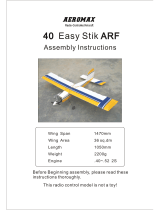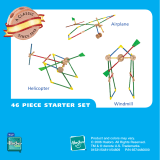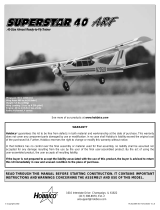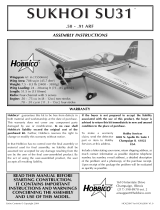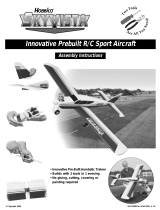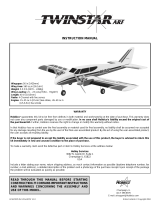Page is loading ...

Tower Trainer
™
40 Ready-to-Fly
RADIO CONTROLLED MODEL AIRPLANE
WARRANTY
Tower Hobbies
®
guarantees this kit to be free from defects in both material and workmanship at the date of purchase. This warranty
does not cover any component parts damaged by use or modification. In no case shall Tower Hobbies’ liability exceed the original
cost of the purchased kit. Further, Tower Hobbies reserves the right to change or modify this warranty without notice.
In that Tower Hobbies has no control over the final assembly or material used for final assembly, no liability shall be assumed nor
accepted for any damage resulting from the use by the user of the final user-assembled product. By the act of using the user-assembled
product, the user accepts all resulting liability.
If the buyer is not prepared to accept the liability associated with the use of this product, the buyer is advised to return this kit
immediately in new and unused condition to the place of purchase.
© Copyright 2002 V1.0
TOWZ1154 for TOWA21**
READ THROUGH THIS MANUAL BEFORE STARTING
CONSTRUCTION. IT CONTAINS IMPORTANT
INSTRUCTIONS AND
WARNINGS CONCERNING THE ASSEMBLY AND USE OF THIS MODEL.

Congratulations and thank you for purchasing the Tower Trainer .40
Ready-to-Fly. You’ve made the right decision by purchasing a “real”
model airplane with a .40-size engine and a 4-channel radio. Once
assembled and set up, there will be no fiddling with a temperamental
engine or constant troubleshooting to figure out how to get the
model to fly. Under the guidance of an experienced flight instructor,
all you’ll have to do is concentrate on learning to fly. And after
you’ve mastered the Trainer .40, the engine and radio may be
installed in your next model!
There are two parts to this manual. The first part, Assembly, guides
you through a few simple steps to put the model together. The second
part, Setup, takes you through initial adjustments and flight
preparation. Do not overlook any of the important setup procedures
and follow the instructions all the way to the end. Anything skipped
in the shop will have to be done at the field.
Here are the names of some of the parts of the model.
If there is no hobby shop in your area, contact the AMA (Academy
of Model Aeronautics), the governing body of model aeronautics.
The AMA can direct you to the closest R/C club whose membership
should have qualified flight instructors. With the added benefit of
insurance coverage provided by the AMA, most clubs require AMA
membership to fly at their field.
1. Your Tower Trainer .40 Ready-to-Fly should not be considered a
toy, but rather a sophisticated, working model that functions very
much like a full-size airplane. Because of its performance
capabilities, the Tower Trainer .40 Ready-to-Fly, if not assembled and
operated correctly, could possibly cause injury to yourself or
spectators and damage to property.
2. You must assemble the model according to the instructions. Do
not alter or modify the model, as doing so may result in an unsafe or
unflyable model. In a few cases the instructions may differ slightly
from drawings or sketches. In those instances the written instructions
should be considered as correct.
3. You must check the operation of the model before every flight to
insure that all equipment is operating and that the model has
remained structurally sound. Be sure to check clevises or other
connectors often and replace them if they show any signs of wear or
fatigue.
Before starting to build, inspect the parts in this kit to make sure they
are of acceptable quality. If any parts are defective or damaged, or if
you need assistance with assembly, contact Product Support.
Product Support:
Phone: (217) 398-8970
Fax: (217) 398-7721
E-mail: [email protected]
KIT INSPECTION
We, as the kit manufacturer, provide you with a top quality kit and
instructions, but ultimately the quality and flyability of your
finished model depends on how you build it; therefore, we cannot
in any way guarantee the performance of your completed model,
and no representations are expressed or implied as to the
performance or safety of your completed model.
PROTECT YOUR MODEL, YOURSELF &
OTHERS...FOLLOW THESE IMPORTANT
SAFETY PRECAUTIONS
Academy of Model Aeronautics
5151 East Memorial Drive
Muncie. IN 47302-9252
Office: (765) 287-1256
Toll Free: (800) 435-9262
Fax: (765) 741-0057
or via the internet at: http//www.modelaircraft.org
IMPORTANT: Once mastered, piloting a model aircraft can be
one of the most enjoyable hobbies around. However, it cannot be
stated strongly enough that, if you do not already know how to fly
an R/C airplane, you will probably not be able to fly this model by
yourself. It may appear to be easy, but over-controlling and
disorientation quickly overcome inexperienced fliers, swiftly
ending their first flight. The best thing you can do to insure success
is to find a flight instructor who will inspect your model for
airworthiness and provide flying lessons. If you haven’t yet done
so, contact the local hobby shop and ask them to introduce you
to an instructor or an R/C club representative. If there is no club
or experienced R/C pilot nearby, it would be worth even a long
drive to find one–if only for just a few flight lessons (then you’ll
have an idea of what to expect).
INTRODUCTION
2

The Tower .46 engine included with this model uses ABC
construction (an A
luminum piston with a Brass cylinder liner that is
C
hrome plated). There is no piston ring, so the fit between the piston
and the liner is intentionally tight. When the engine is new, this built-
in “tightness” causes the propeller to be difficult to rotate when the
piston gets to the top—the engine may even squeak. Do not be
alarmed because this is normal. After the engine has been run a few
times the propeller will be easier to turn and the squeaking will
disappear.
Notice: Due to the initial “tightness” of this engine, using an electric
starter is highly recommended—at least until the engine has been
broken-in. If you do not have an electric starter, starting the engine
with a model engine starting stick is acceptable. If started this way,
first lubricate the engine with model engine after run oil
(HCAP3000). To do so, remove the glow plug, add five to seven
drops of oil to the top of the piston, then rotate the propeller at least
one-dozen times. Replace the glow plug. Now the engine may be
started with the starting stick.
When ready to fly, you’ll need the equipment to fuel the plane and
start the engine. The most important items include an electric starter,
12 Volt battery, fuel pump (electric or hand-crank), fueling lines and
fittings and a 1.5 Volt glow plug igniter. Your flight instructor may
share his equipment with you for a while, but eventually you’ll need
your own. Visit your local hobby dealer or see the Tower Hobbies
catalog for a full selection, descriptions and pricing. You can also
visit our web site at www.towerhobbies.com.
FIELD EQUIPMENTENGINE STARTING
3
1/64" = .4 mm
1/32" = .8 mm
1/16" = 1.6 mm
3/32" = 2.4 mm
1/8" = 3.2 mm
5/32" = 4.0 mm
3/16" = 4.8 mm
1/4" = 6.4 mm
3/8" = 9.5 mm
1/2" = 12.7 mm
5/8" = 15.9 mm
3/4" = 19.0 mm
1" = 25.4 mm
2" = 50.8 mm
3" = 76.2 mm
6" = 152.4 mm
12" = 304.8 mm
18" = 457.2 mm
21" = 533.4 mm
24" = 609.6 mm
30" = 762.0 mm
36" = 914.4 mm
METRIC CONVERSIONS

❍ 1. For safety reasons, the model is shipped with the battery pack
in the model (the receiver battery) disconnected. In the fuselage,
connect the plug from the battery pack, colored red, to the plug from
the on/off switch, labeled “BATTERY.”
❍ 2. Presently, the batteries are not fully charged. They may require
additional charging for setting up the radio later. If you plan to
assemble the plane now, the batteries may be charged later. If you
plan to assemble the plane later, charge the batteries following the
instructions in the instruction manual supplied for the radio control
system. Note: When charging the receiver battery, connect the
charger to the plug labeled “CHARGE” inside the fuselage.
❍ 1. Guide the aileron servo wire under the servo tray and out of
the wing.
❍ 2. Join both wing halves using the joiner rod and the alignment
pin.
❍ 3. Use two metal straps and four 3 x 8mm screws (the small
screws with the washers attached) to hold the wing halves together.
(Note the metal strap near the trailing edge of the wing, partially
concealed in the photo). Connect the pushrods to the torque rod
horns with the clevises and clevis retainers.
❍ 1. Insert the main landing gear wires into the holes in the landing
gear rail in the bottom of the fuselage. Secure the gear with two
nylon straps and four 3 x 12mm screws.
❍ 2. Insert both wood wing dowels into the fuselage. Secure both
ends of each dowel with a plastic dowel cap and a 3 x 8mm screw.
Assemble the Fuselage
Assemble the Wing
Charge the Batteries
ASSEMBLY
4

❍ 3. Insert the horizontal stabilizer (also referred to as the
“stabilizer,”
or just “stab”) into the fuselage. Insert the vertical stabilizer (also
referred to as “fin”) into the stab, guiding the threaded rods through
the holes in the stab and the bottom of the fuselage.
❍ 4. Secure the fin and stab with a 3mm washer and 3mm lock nut
on each threaded rod. Be certain to tighten the nuts securely, but do
not over tighten so as to damage the bottom of the fuselage.
❍ 5. Connect the clevis on the elevator pushrod to the second-from-
the-bottom hole in the elevator control horn. Connect the clevis on
the rudder pushrod to the middle hole in the rudder control horn.
❍ 6. Fit the spinner back plate, followed by the propeller, propeller
washer and propeller nut on the engine. Position the propeller so it
is contacting the molded-in alignment pegs on the back plate.
Tighten the prop nut with your fingers.
❍ 7. Use a 7/16" wrench, an 11mm wrench or a crescent wrench to
tighten the prop nut 1/2 turn, plus 1/8 turn. Fit the spinner cone to
the back plate, then use a #1 Phillips screwdriver to tighten the
spinner screws.
If you have not yet charged the batteries, you may still proceed.
However, as the batteries have not yet been fully charged, they may
not provide enough power to make it all the way through the setup
procedures. If the batteries quit working, set your tools aside and
charge the batteries as described in the instruction manual for the
Tower Hobbies radio control system that came with this kit.
Now the plane is assembled, but there are a few things that must
be done before it will be ready to fly. You must carefully perform
all of the following Setup procedures. If possible, have your flight
instructor assist.
SETUP
+ 1/8 Turn
1/2 Turn
5
CAUTION: The model is not yet ready to fly.
Proceed to the setup procedures in the following
section to prepare the model for flying.

The first thing that has to be done is to make sure all the controls
move in the right direction.
❍ 1. Connect the aileron servo wire coming from the wing to the
plug labeled “AILERON” coming from the receiver inside the
fuselage. Temporarily mount the wing to the fuselage with a couple
of #64 rubber bands supplied with this kit.
❍ 2. Turn on the transmitter, followed by the receiver. (The idea is to
never have the receiver on by itself. When turning off the system,
turn off the receiver first, then the transmitter.)
❍ 3. Move the right control stick on the transmitter to the right as
shown in the diagram. Observe the direction the ailerons move. The
right aileron should move up and the left aileron should move down.
Moving the control stick to the left should make the ailerons move
the opposite way. If the ailerons do not respond as described, reverse
the direction using the reversing switch for the aileron on the
transmitter. If necessary, refer to the instructions in the Tower
Hobbies
instruction manual to identify and operate the reversing switch.
❍ 4. Move the right stick down and observe the direction the
elevator moves. Moving the right stick down should make the
elevator move up. Move the left stick to the right and observe the
rudder. Moving the stick to the right should make the rudder (and the
nose wheel) move to the right. Move the left stick down and make
sure the carburetor closes. If necessary, use the reversing switches on
the transmitter to make the elevator, rudder and throttle respond in
the correct direction.
The next thing that has to be done is to make sure the controls move
the correct amount.
The control throws are a measure of how far the flight controls
(ailerons, elevator and rudder) move. If the controls move too much,
the plane will respond too quickly and be difficult to control. If the
controls do not move enough, it may not be possible to recover the
plane from adverse situations or to flare for landing. Due to the great
effect the control throws have on the way a model flies, the control
throws must be checked.
Set the Control Throws
Note that pulling the elevator stick back moves the elevator up
(which, in flight, pushes the tail down, thus increasing the angle of
the wing, thereby making the model climb). The best way to keep
this in mind is to think in terms of a pilot in an airplane. He pulls
the control stick back to “pull up” the nose of the plane.
Move Stick Right
Rudder (and Nosewheel)
Move Right
Pull Stick Back (Down)
Elevator Moves Up
Move Stick Right
Right Aileron Goes Up
Left Aileron Goes Down
Check the Control Directions
6

❍ 1. Make certain the pushrods are connected to the servo arms as
follows: The elevator pushrod should be in the second hole out on
the servo arm, the rudder pushrod should be in the third hole out on
the servo arm, and the aileron pushrods should be in the second hole
out on the servo arm. If the pushrods are not connected to the servo
arms as described, remove the nylon connector, insert the pushrod
in the correct hole, then reinstall the nylon connector.
❍ 2. Turn on the transmitter and receiver. Center all the trim levers
on the transmitter.
We’ll do the elevator first…
❍ 3. View the elevator and stab from the end. The elevator should be
centered as shown in the sketch at the top. If the elevator is not
centered with the stab (as shown in the bottom sketch), disconnect
the clevis from the elevator control horn. Holding the end of the
pushrod with pliers, thread or unthread the clevis as necessary until
the elevator is centered when reconnected to the pushrod.
❍ 4. Hold a ruler to the trailing edge of the elevator, resting one end
on the workbench. Move the elevator all the way up by moving the
control stick on the transmitter all the way down. Measure the
distance the elevator moves. As shown in the chart on page 8, the
elevator should move up 7/16" [11mm]. Measure the distance the
elevator moves down.
❍ 5. If the elevator moves up 7/16" [11mm] and down 7/16" [11mm]
the elevator throw is correct (a variance of 1/16" [1.5mm] is
acceptable). If the elevator does not move up and down 7/16"
[11mm], the elevator pushrod must be move to a different hole in
either the servo arm and/or the control horn. This will change the
geometry and increase or decrease the throw. Refer to the diagram
on the following page and relocate the elevator pushrod as necessary
to adjust the throw so the elevator will move up and down 7/16"
[11mm].
Stabilizer
Elevator
Elevator NOT Centered With Stab
Elevator Centered With Stab
7

To get the controls to move farther (increase the throw), connect the
pushrod to a hole farther in on the control horn, or connect the
pushrod to a hole farther out on the servo arm. To get the controls to
move less (decrease the throw), connect the pushrod the opposite as
described above.
❍ 6. Center the rudder and ailerons by adjusting the clevises on the
pushrods as necessary. Measure the rudder and aileron throws the
same as was done with the elevator. Refer to the Control Throws
Chart below for the correct measurements. If any of the throws are
not correct, the throws must be adjusted by moving the pushrod to a
different hole in either the servo arm or the control horn as
previously described.
❍ 7. If necessary, center the nose wheel by loosening the screw in
the screw-lock pushrod connector on the rudder servo arm. Move
the pushrod forward or back to center the wheel. Securely tighten
the screw.
The throttle is to be set up so that when the throttle stick is all the way
down, and the throttle trim lever is all the way up, the carburetor will
be nearly, but not fully closed and the engine will idle at a low RPM.
This will keep the engine running when the throttle stick is pulled all
the way down (toward you) for landing. When it is time to shut the
engine off after landing, move the trim lever down to close the
carburetor the rest of the way.
Here’s how to set up the carburetor…
❍ 1. With the transmitter and receiver on, move the throttle trim
lever and the throttle stick all the way down.
❍ 2. Observe the opening in the carburetor. If the carburetor is fully
closed, proceed to step 3. If the carburetor is nearly, but not fully
closed, loosen the screw on the screw-lock connector on the throttle
servo arm and move the pushrod back until the carburetor is closed.
Securely tighten the screw.
❍ 3. Move the throttle trim lever all the way up, but leave the throttle
stick all the way down. Now the carburetor should be partially open
(about 1/32" to 1/16" [1 to 1.5mm]).
Trim Lever Up
Throttle
Stick Down
Trim Lever Down
Throttle
Stick Down
Adjust the Throttle
CONTROL THROWS CHART
AILERONS: 5/16" [8mm] up 5/16" [8mm] down
ELEVATOR: 7/16" [11mm] up 7/16" [11mm] down
RUDDER: 1" [25mm] right 1" [25mm] left
8

❍ 4. Move the throttle stick all the way up. The carburetor should be
fully open.
❍ 5. If you are not able to achieve these settings, more or less
movement may be required from the throttle pushrod. The same as
the control surface throws, this is done by relocating the clevis on the
carburetor arm to the other hole, or by relocating the pushrod
connector on the servo arm to another hole.
Whether you fly at an R/C club or somewhere on your own, you
should have your name, telephone number, address and AMA
number on or in your model so it can be identified and returned in
case it lands somewhere away from the flying site. Fill out the I.D.
tag found in the back of the manual and use spray adhesive or tape
to stick it in the model.
This important step is also referred to as “checking the C.G.” (center
of gravity). Simply stated, the center of gravity is the point at which
the model balances when lifted under the wing. If the C.G. is too far
forward, the model will be “nose-heavy” and could be difficult to
takeoff and land and lose some of its self-correcting tendencies. If the
C.G. is too far aft, the model will be “tail-heavy” and the controls
may be too sensitive, making the model too difficult to
control–especially
for an inexperienced pilot! DO NOT DISREGARD THIS STEP!
Follow the instructions to balance the model correctly, thus giving
you the greatest chances for success!
❍ 1. Use narrow tape or a felt-tip pen to mark two lines on the
bottom of the wing where shown in the photo.
❍ 2. Make certain the model is in “ready-to-fly” condition with all
components mounted and installed (propeller, spinner, landing gear,
etc.). The fuel tank must be empty.
❍ 3. Mount the wing to the fuselage with four rubber bands. Lift the
model on both sides of the fuselage with your fingertips between the
lines on the bottom of the wing.
❍ 4. Position your fingers anywhere between the lines until you can
get the fuselage level. If the tail remains low even when your fingers
are on the aft line, the model is tail-heavy and will require weight on
the nose to get it to balance. If, however, the nose of the model
remains low even when your fingers are on the forward line, the
model is nose-heavy and will require weight on the tail to get it to
balance. “Out of the box” the model should balance with your
fingers between the lines, but they will probably be nearer the front
line. This is okay as long as you can get the model to balance with
your fingers anywhere between the lines.
If additional weight is required to balance the plane, purchase Great
Planes Self Adhesive Lead Weights (GPMQ4485). The weight is
Balance the Model
Identify Your Model
9

segmented in 1/4 oz. increments and is easy to work with. If adding
weight to the tail, attach it to the left side of the fuselage (opposite
the muffler) under the stab. If adding weight to the nose, attach it to
the inside of the fuselage next to the engine.
❍ 5. If you found it necessary to add weight, recheck the C.G. after
doing so.
Note: Once you have mastered flying the Tower Trainer .40 Ready-
to-Fly, you may experiment by moving the C.G forward or aft, as long
as it remains between the lines. Moving the C.G. forward (adding
weight to the nose) will improve the model’s stability, but may make
it a little more difficult to flare for landing. Moving the C.G. aft
(adding weight to the tail) will increase the model’s maneuverability,
but could also make it too sensitive for beginners to control. Never
move the C.G. outside the lines.
Now it’s time to do a final check before taking the model to the field.
These checks are best done in the peace and comfort of your own
shop, so take the time now to make certain your model is ready.
❍ 1. Check to see that the screws on the wheel collars that hold on
the wheels are fully tightened.
❍ 2. Be certain the silicone retainers on all the nylon clevises are
in position.
❍ 3. Make certain the elevator, rudder and ailerons respond in the
correct directions.
❍ 4. Make certain the wing is securely joined with the metal
straps.
❍ 5. Check to see that the nuts that hold the fin and stab in
position are present and secure.
❍ 6. Inspect the rubber bands that hold the wing on and make sure
they are in good condition.
❍ 7. Make certain the propeller and propeller spinner are secure.
❍ 8. Make certain you have balanced the model according to the
instructions.
❍ 9. Check to see that the screws that hold the servo arms to the
servos are present and secure.
❍ 10. Make certain you have filled out the I.D. card and placed it
inside the model.
If you haven’t already done so, refer to the Tower Hobbies instruction
manual for the radio control system and charge the batteries in the
plane and in the transmitter overnight the night before you go flying.
In addition the equipment required to fuel and start the engine
mentioned near the beginning of the manual, you should start a
collection of tools that may be required for adjustments and
maintenance at the flying field. Following is a list of the most
important items.
Tools:
❍ Medium (#1) Phillips screwdriver
❍ Large (#2) Phillips screwdriver
❍ 5/16" (or 8mm) Socket wrench (for glow plug)
❍ 7/16" or 11mm Wrench or crescent wrench (for propeller nut)
❍ Pliers
❍ Hobby knife
Spare Parts:
❍ 10 x 6 propellers
❍ Glow plug
❍ #64 rubber bands (stored in container with talcum powder or
kitty litter)
Flight preparation is to be done at the flying field.
Be certain your flight instructor performs these following checks
with you.
❍ 1. Get the frequency clip from the frequency control board at your
flying site.
❍ 2. Mount the wing to the fuselage with the #64 rubber bands
supplied with this kit. Ten to twelve rubber bands are suggested. Be
certain the final two are "crisscrossed," thus ensuring that the others
remain secure.
❍ 3. Turn on the transmitter and receiver. One at a time, operate
each control on the airplane using the sticks on the transmitter. Make
certain each control is responding correctly. This must be done
before
every flight. There are several types of malfunctions that can be
discovered
by performing this elementary task, thus saving your model!
Check the Controls
IMPORTANT: Your radio control system transmits a signal on a
certain frequency. Be certain you know what the frequency is. This
is expressed as a two-digit number (42, 56, etc.), and can be found
on the container the transmitter came in and is also located on the
transmitter. There are several different frequencies, but there is still
a chance that someone else at the flying field may be on the same
frequency as you. If you turn on your transmitter while that person
is flying, a crash will result. NEVER turn on your transmitter until
you have permission from your instructor, and until you have
possession of the frequency clip used for frequency control at the
flying site.
FLIGHT PREPARATION
Gather Your Tools
Charge the Batteries
Ten-Point Check List
10

A range check must be performed before the first flight of a new
model. It is not necessary to do a range check before every flight (but it
is not a bad idea to perform a range check before the first flight of each
day). A range check is the final opportunity to reveal any radio
malfunctions,
and to be certain the system has adequate operational range.
❍ 1. Turn on the transmitter and receiver. Leave the transmitter
antenna all the way down. Walk away from the model while
simultaneously operating the controls. Have an assistant stand by the
model and tell you what the controls are doing to confirm that they
operate correctly. You should be able to walk approximately 100 feet
from the model and still have control without any “glitching” or
inadvertent servo operation.
❍ 2. If everything operates correctly, return to the model and start the
engine. Perform the range check with your assistant holding the
plane with the engine running at various speeds. If the servos chatter
or move inadvertently, there may be a problem. Do not fly the plane!
With the assistance of your instructor, look for loose servo
connections or binding pushrods. Also be certain you are the only
one on your frequency, and that the battery has been fully charged.
The following flying instructions are in no way an endorsement for
learning to fly on your own, but are printed so you can know what
to expect and what to concentrate on while learning under the
tutelage of your instructor. Further, these flight instructions may be
referenced once you begin flying on your own.
Remember, it is assumed that your instructor is operating the model
for you.
Before the model is ready for takeoff, it must first be set up to roll
straight down the runway. With the engine running at a low idle,
place the plane on the runway and, if your flying field permits, stand
behind the model. Advance the throttle just enough to allow the
model to roll. If the model does not roll straight down the runway,
shut the engine off and adjust the nose gear pushrod as necessary.
Do not use the rudder trim to correct the nose wheel because this
will also affect the rudder. Note: Crosswinds may affect the direction
the model rolls, so this test should be done in calm conditions, or
with the model facing directly into the wind.
If possible, takeoff directly into the wind. If you are experienced,
taking off in a crosswind is permissible (and sometimes
necessary–depending upon the prevailing wind conditions and
runway heading). Taking off into the wind will help the model roll
straight and also reduces ground speed for takeoff. Taxi the model
onto the runway or have an assistant carry it out and set it down
pointing down the runway into the wind. When ready, gradually
advance the throttle while simultaneously using the left stick
(rudder/nose wheel) to steer the model. Gain as much speed as the
runway and flying site will practically allow before gently applying
up elevator, lifting the model into the air. Be ready to make
immediate corrections with the ailerons to keep the wings level, and
be smooth on the elevator stick, allowing the model to establish a
gentle climb to a safe altitude before making the first turn (away from
yourself). Do not “yank” back the elevator stick, forcing the plane
into too steep of a climb which could cause the model to quit flying
and stall.
Once airborne, maintain a steady climb and make the initial turn
away from the runway. When at a comfortable, safe altitude, throttle
back to slow the model, thus giving you time to think and react. The
Tower Trainer should fly well at half or slightly less than half-throttle.
Adjust the trims so the plane flies straight and level. After flying
around for a while, and while still at a safe altitude with plenty of
fuel, practice slow flight and execute practice landing approaches by
reducing the throttle further to see how the model handles when
coming in to land. Add power to see how the model climbs as well.
Continue to fly around while learning how the model responds.
Mind your fuel level, but use this first flight to become familiar with
the model before landing.
When ready to land, pull the throttle stick fully back while flying
downwind just before making the 180-degree turn toward the
runway. Allow the nose of the model to pitch downward to gradually
bleed off altitude. Continue to lose altitude, but maintain airspeed by
keeping the nose down while turning. Apply up elevator to level the
plane when it reaches the end of the runway and is about five to ten
feet off the ground. If the model is too far away, carefully add a small
amount of power to fly the model closer. If going too fast, smoothly
advance the throttle and allow the model to gain airspeed, then
apply elevator to climb-out and go around to make another attempt.
When finally ready to touch down, continue to apply up
elevator, but
not so much that the airplane will climb. Continue to
apply up elevator
while the plane descends until it gently touches down.
After you have landed and shut the engine off, adjust the pushrods
on the ailerons, elevator and rudder as necessary so the trim levers
on the transmitter may be returned to center (this will not be required
on any of the controls that did not need trim adjustments).
Landing
Flight
Takeoff
Taxiing
IMPORTANT: If you do insist on flying on your own, you must be
aware of your proximity to R/C club sites. If there is an R/C site
within six miles of where you are flying, and if you are operating
your model on the same frequency at the same time as somebody
else, there is a strong possibility that one or both models will crash
due to radio interference. There is great potential for an out-of-
control model to cause property damage and/or severe personal
injury. We strongly urge you to fly at a R/C club site where
frequency control is in effect so you can be assured you will be the
only one flying on your channel.
FLYING
Range Check the Radio
11

❍ 1. After flying for the day, use your fuel pump to drain excess fuel
from the tank.
❍ 2. Purchase spare #64 rubber bands for the wing (TOWQ1220,
1/4 lb box). Do not reuse torn or oily rubber bands. After flying,
remove the oily rubber bands from the wing and store them in a
container with talcum powder or kitty litter. This will absorb oil and
keep the rubber bands fresh for the next flying session.
❍ 3. After each day’s flying, use spray cleaner and paper towels to
thoroughly clean the model.
❍ 4. The Tower Hobbies Trainer .40 Ready-to-Fly is factory-covered
with iron-on model covering film. Should repairs ever be required,
the covering can be patched with new pieces of iron-on covering.
Among several types of covering that will work, Top Flite
®
MonoKote
®
film may be used to make repair patches to this model.
MonoKote is packaged in six-foot rolls, but some hobby shops also
sell it by the foot. If only a small piece of covering is needed for a
minor patch, perhaps a fellow modeler would give you some. The
covering is applied with a model airplane covering iron, but in an
emergency a regular iron could be used.
Make a copy of the identification tag shown below and place it on
or inside the model.
Maintenance Tips
Ordering Replacement Parts
To order replacement parts for the Tower Trainer .40 Ready-to-Fly, use the order numbers in the Replacement Parts List that follows.
Replacement parts are available only as listed. Not all parts are available separately (an aileron cannot be purchased separately, but
is only available with the wing set). Replacement parts are not available from Product Support, but can be purchased from Tower
Hobbies. Hardware items (screws, nuts, bolts) are also available from Tower. If this kit is missing parts, contact Product Support.
Replacement Parts List
Or
der Number Description How to Purchase
Missing pieces..............................Contact Product Support
Instruction manual........................Contact Product Support
Plans.............................………….Not available
TOWA6015 ............................Wing Set
TOWA6016 ............................Fuselage Set
TOWA6018 ............................Landing Gear Set
TOWA6017 ............................Tail Set
Contact Tower Hobbies
to purchase these items
/
